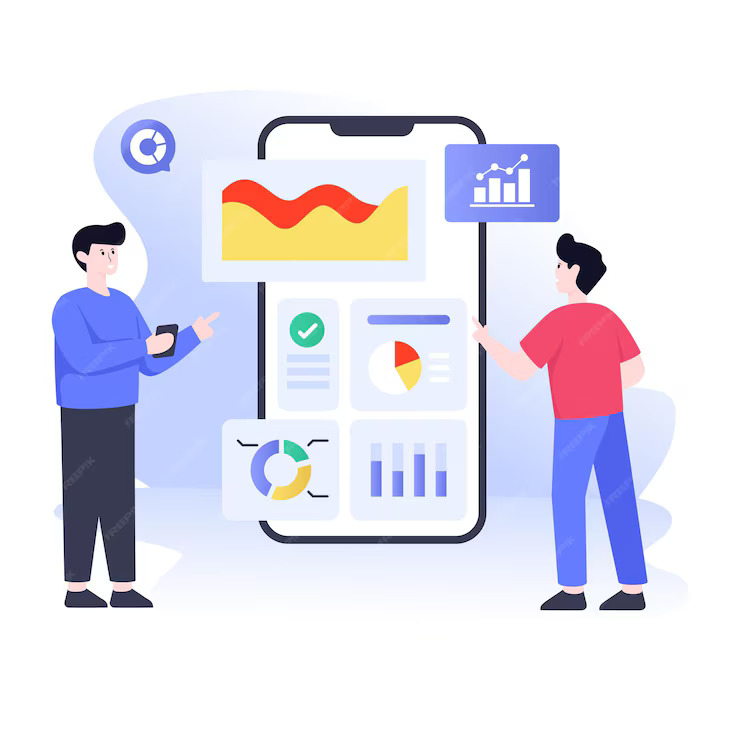


In today’s interconnected world, where consumers are increasingly glued to their digital devices, the landscape of marketing has undergone a profound evolution. Digital marketing has emerged as a powerful catalyst, reshaping traditional advertising strategies and redefining how businesses engage with their audiences. This transformation isn’t merely a shift in medium but a seismic revolution that empowers brands to connect with consumers in more meaningful, targeted, and measurable ways than ever before.
Digital marketing transcends the limitations of traditional methods by leveraging the vast potential of online platforms, social media channels, and data-driven insights. Unlike static print ads or broadcast commercials, digital marketing thrives on interactivity, personalization, and real-time engagement. It allows brands to tailor their messages with precision, reaching specific demographics based on interests, behaviors, and browsing patterns.
Moreover, the agility of digital marketing enables brands to adapt swiftly to market trends and consumer preferences. Campaigns can be optimized on the fly, responses can be immediate, and results can be measured in granular detail. This capability not only enhances the effectiveness of marketing efforts but also provides invaluable insights that inform future strategies.
Furthermore, digital marketing facilitates global reach with unprecedented ease, enabling businesses of all sizes to expand their presence beyond geographical boundaries and tap into new markets. Whether through targeted advertising, content marketing, or e-commerce strategies, digital platforms empower brands to connect with diverse audiences worldwide.
In this blog, we delve into the transformative power of digital marketing, exploring its key advantages over traditional advertising methods and showcasing real-world examples of successful campaigns. Join us as we uncover how digital marketing is not just an evolution, but a revolution in the way businesses communicate, engage, and thrive in the digital age.
Targeted Reach and Precision: How Digital Marketing Allows You to Pinpoint Your Audience with Laser Accuracy
Digital marketing excels in its ability to precisely target specific audiences, unlike traditional advertising methods. Here’s how:
- Advanced Targeting Tools: Platforms like Google Ads and social media channels offer sophisticated targeting options based on demographics, interests, behaviors, and even specific locations. This allows marketers to tailor their messages directly to the most relevant audience segments.
- Personalized Campaigns: By leveraging data analytics and consumer insights, digital marketers can create personalized campaigns that resonate with individual preferences and purchasing behaviors. This personalized approach enhances engagement and conversion rates significantly.
- Improved Conversion Rates: Targeted marketing ensures that your messages reach those who are more likely to be interested in your products or services, thereby increasing the likelihood of conversion. This efficiency in targeting leads to better ROI on marketing investments.
- Reduced Wastage: Unlike traditional mass advertising, digital marketing minimizes wastage by delivering ads only to the intended audience. This not only saves costs but also enhances the effectiveness of the campaign by focusing efforts where they are most likely to yield results.
- Continuous Refinement: Digital marketing campaigns can be continuously optimized based on real-time data and feedback. Marketers can adjust their targeting parameters, messaging, and even the timing of their campaigns to maximize impact and ROI.
- Tracking and Measurement: Through digital marketing platforms, marketers can track the performance of their campaigns in real-time. Metrics such as click-through rates, conversions, and engagement levels provide actionable insights for refining targeting strategies and optimizing future campaigns.
Real-Time Analytics and Data Insights: Leveraging Digital Marketing for Instant Feedback and Actionable Intelligence
Digital marketing’s ability to provide real-time analytics and data insights is a game-changer in the advertising landscape:
- Immediate Feedback: Unlike traditional methods where feedback is delayed, digital marketing campaigns provide instant feedback on various metrics such as engagement rates, click-through rates, and conversions. This allows marketers to quickly assess the effectiveness of their strategies and make necessary adjustments in real-time.
- Data-Driven Decision Making: Digital marketing relies heavily on data analytics to understand consumer behavior, preferences, and trends. By analyzing this data, marketers gain valuable insights into their target audience’s needs and preferences, enabling them to create more targeted and personalized campaigns.
- Predictive Analytics: Advanced digital marketing tools use predictive analytics to forecast future trends and consumer behavior patterns. This foresight allows marketers to proactively adjust their strategies and stay ahead of the competition.
- Campaign Optimization: Real-time analytics enable marketers to optimize their campaigns on the fly. By identifying underperforming areas or high-performing segments, marketers can allocate resources more effectively and maximize ROI.
- Competitive Advantage: Access to real-time data gives marketers a competitive advantage by allowing them to adapt quickly to market changes and consumer preferences. This agility ensures that marketing efforts remain relevant and impactful in a fast-paced digital landscape.
- Continuous Improvement: Digital marketing fosters a culture of continuous improvement by encouraging iterative testing and optimization. Marketers can experiment with different strategies, measure results in real-time, and refine their approach based on data-driven insights.
Cost-Effectiveness and ROI: Understanding How Digital Marketing Maximizes Your Budget and Delivers Tangible Returns
Digital marketing stands out for its cost-effectiveness and ability to deliver measurable returns on investment (ROI):
- Targeted Spending: Digital marketing allows marketers to allocate their budget more effectively by targeting specific audience segments. Unlike traditional methods that rely on broad demographic data, digital platforms enable precise targeting based on interests, behaviors, and online activities.
- Pay-per-Click (PPC) Advertising: Platforms like Google Ads and social media ads operate on a PPC model, where advertisers only pay when users interact with their ads. This ensures that marketing dollars are spent on actual engagement rather than mere impressions.
- Measurable Metrics: Digital marketing provides robust analytics tools that track key performance indicators (KPIs) such as conversion rates, click-through rates, and cost per acquisition (CPA). These metrics offer clear insights into campaign effectiveness and ROI, allowing marketers to justify their spending and optimize future strategies.
- Scalability: Digital marketing campaigns can be scaled up or down based on budget constraints and business goals. Whether targeting a niche market or launching a large-scale campaign, digital platforms offer flexibility in budget allocation and spending.
- Lower Overheads: Compared to traditional advertising channels like print or TV, digital marketing typically involves lower production and distribution costs. Marketers can create and distribute content online at a fraction of the cost, making it accessible to businesses of all sizes.
- Competitive Advantage: Small and medium-sized enterprises (SMEs) can compete on equal footing with larger corporations through strategic digital marketing. By targeting niche audiences and maximizing ROI, SMEs can carve out a significant market presence without breaking the bank.
Interactive and Engaging Campaigns: Crafting Digital Strategies That Captivate Audiences and Drive Meaningful Interactions
Digital marketing excels in creating interactive and engaging campaigns that resonate with audiences on a personal level:
- Two-Way Communication: Unlike traditional advertising, which is often one-sided, digital marketing encourages two-way communication between brands and consumers. Social media platforms, blogs, and interactive websites enable direct engagement, feedback, and dialogue.
- Content Variety: Digital marketing offers diverse formats for content creation, including videos, infographics, quizzes, and polls. This variety allows marketers to cater to different preferences and capture audience attention through visually compelling and interactive content.
- Personalization: Through data-driven insights, digital marketers can personalize content and messaging based on user preferences, behaviors, and past interactions. Personalized campaigns resonate more deeply with audiences and foster a sense of connection and loyalty.
- User-Generated Content (UGC): Encouraging users to create and share content related to your brand fosters community engagement and authenticity. UGC campaigns leverage social proof and word-of-mouth marketing, driving organic reach and building brand credibility.
- Interactive Experiences: Digital marketing leverages interactive experiences such as gamification, virtual reality (VR), and augmented reality (AR) to create immersive brand experiences. These innovative approaches capture attention and leave a lasting impression on consumers.
- Call-to-Action (CTA) Optimization: Digital campaigns integrate effective CTAs that prompt users to take specific actions, such as signing up for a newsletter, making a purchase, or sharing content. Well-crafted CTAs enhance conversion rates and drive measurable results.
Global Reach and Accessibility: Expanding Your Brand’s Horizon with Digital Marketing’s Borderless Potential
Digital marketing transcends geographical boundaries, offering unparalleled global reach and accessibility:
- Global Audience Targeting: Digital platforms enable businesses to reach international audiences with targeted campaigns tailored to local preferences and cultural nuances. This strategic approach expands market reach and facilitates brand expansion into new territories.
- 24/7 Accessibility: Unlike traditional storefronts with limited operating hours, digital marketing ensures round-the-clock accessibility to products and services. Websites, e-commerce platforms, and social media channels allow consumers to engage with brands at their convenience, regardless of time zones.
- Multilingual Content: Digital marketing accommodates multilingual audiences through localized content and language-specific campaigns. Translated websites, social media posts, and advertisements resonate more effectively with diverse global demographics, enhancing engagement and conversion rates.
- Cross-Border E-commerce: Digital marketing facilitates cross-border e-commerce by overcoming logistical barriers and enabling seamless transactions. International shipping, payment gateways, and localized customer support contribute to a frictionless shopping experience for global consumers.
- Cultural Sensitivity: Successful global marketing campaigns prioritize cultural sensitivity and adaptability to resonate with diverse audiences. Understanding local norms, values, and consumer behaviors enhances brand authenticity and fosters trust on a global scale.
- Market Expansion Strategies: Digital marketing strategies such as SEO, PPC advertising, influencer partnerships, and social media localization drive market penetration and brand visibility in new international markets. These strategies support sustainable growth and competitive advantage in a globalized economy.
Adaptability and Agility in Campaign Management: Harnessing the Flexibility of Digital Platforms to Stay Ahead in a Dynamic Market
Digital marketing’s adaptability and agility enable marketers to navigate and thrive in a fast-paced, ever-changing market environment:
- Real-Time Adjustments: Digital campaigns can be adjusted in real-time based on performance metrics, consumer feedback, and market trends. This agility allows marketers to capitalize on opportunities quickly and mitigate potential risks proactively.
- Seasonal Campaigns: Digital platforms facilitate the creation and deployment of seasonal campaigns, promotions, and holiday-themed content. Marketers can adapt messaging and strategies to align with seasonal trends, consumer behaviors, and purchasing patterns.
- Agile Marketing Techniques: Agile methodologies such as rapid prototyping, iterative testing, and continuous optimization are inherent to digital marketing practices. These techniques promote innovation, efficiency, and responsiveness in campaign management and execution.
- Responsive Design: Mobile-responsive websites and digital content ensure a seamless user experience across devices and screen sizes. Responsive design enhances accessibility, engagement, and conversion rates by accommodating diverse consumer preferences and behaviors.
- Emerging Technologies: Digital marketing embraces emerging technologies such as artificial intelligence (AI), machine learning (ML), and automation tools to streamline campaign management processes. These technologies enhance efficiency, data analysis capabilities, and predictive modeling for informed decision-making.
- Competitive Intelligence: Digital marketers leverage competitive intelligence tools and analytics to monitor competitor activities, market trends, and industry developments. This strategic insight informs campaign strategies, positioning strategies, and differentiation tactics to maintain a competitive edge.
Frequently Ask Questions(FAQs)
Q1. How does digital marketing differ from traditional advertising methods?
Answer: Digital marketing differs from traditional advertising methods in several fundamental ways. Unlike traditional advertising, which includes mediums like print, television, and radio, digital marketing leverages online platforms such as social media, search engines, and websites. One of the primary distinctions is the level of interactivity and targeting precision digital marketing offers. Traditional methods often rely on broad demographic data, while digital marketing allows for highly targeted campaigns based on specific user behaviors, interests, and demographics. Additionally, digital marketing campaigns are measurable in real-time, providing immediate feedback on engagement metrics such as clicks, conversions, and impressions. This data-driven approach enables marketers to optimize campaigns continuously, something traditional advertising struggles to achieve.
Q2. What are the key advantages of digital marketing over traditional advertising?
Answer: Digital marketing offers several advantages over traditional advertising, including:
- Targeted Reach: Digital marketing allows businesses to reach highly specific audiences based on demographics, behaviors, and interests, increasing the likelihood of engagement and conversion.
- Cost-Effectiveness: Compared to traditional methods like TV or print ads, digital marketing can be more cost-effective due to its ability to target specific audiences and track ROI more accurately.
- Real-Time Analytics: Digital marketing provides instant feedback through analytics tools, allowing marketers to adjust campaigns in real-time for better performance.
- Global Reach: With digital marketing, businesses can reach global audiences instantly, breaking down geographical barriers and expanding market reach.
- Interactivity and Engagement: Digital platforms enable interactive campaigns that engage users through various formats like videos, polls, and quizzes, fostering deeper connections with the audience.
Q3. How can businesses measure the success of their digital marketing campaigns?
Answer: Measuring the success of digital marketing campaigns involves tracking key performance indicators (KPIs) that align with business objectives. Common metrics include:
- Conversion Rate: The percentage of website visitors who complete a desired action, such as making a purchase or filling out a form.
- Click-Through Rate (CTR): The percentage of users who click on a specific link or ad out of the total number of users who viewed it.
- Cost per Acquisition (CPA): The cost associated with acquiring a new customer through digital marketing efforts.
- Engagement Metrics: Metrics like likes, shares, comments, and time spent on site indicate audience engagement and content effectiveness.
- Return on Investment (ROI): Calculating ROI helps businesses understand the profitability of their digital marketing campaigns by comparing the revenue generated to the cost of the campaign.
Using analytics platforms such as Google Analytics, social media insights, and marketing automation tools, businesses can gain valuable insights into campaign performance, identify areas for improvement, and optimize strategies for better results.
Q4. How can digital marketing help businesses stay competitive in the market?
Answer: Digital marketing enhances a business’s competitive edge by:
- Enhancing Brand Visibility: Digital platforms increase brand visibility through targeted advertising, SEO strategies, and content marketing, ensuring businesses remain visible to their target audience.
- Improving Customer Engagement: Interactive and personalized digital campaigns foster deeper connections with customers, increasing brand loyalty and advocacy.
- Adapting to Market Changes: Digital marketing allows businesses to adapt quickly to market trends and consumer behaviors, enabling agile responses and strategic adjustments.
- Expanding Market Reach: Global reach through digital channels enables businesses to tap into new markets and customer segments, driving growth opportunities beyond local boundaries.
- Measuring and Optimizing Performance: Real-time analytics provide actionable insights that businesses can use to refine their marketing strategies, optimize campaigns, and maximize ROI.
By leveraging digital marketing strategies effectively, businesses can not only survive but thrive in competitive markets, continually evolving to meet consumer demands and market dynamics.
Q5. What are some successful examples of digital marketing campaigns?
Answer: Several digital marketing campaigns have achieved remarkable success by leveraging innovative strategies and engaging content:
- Nike’s “Just Do It” Campaign: Nike’s iconic slogan campaign encouraged consumers to embrace an active lifestyle, leveraging social media platforms to amplify their message and engage with a global audience.
- Dove’s “Real Beauty” Campaign: Dove’s campaign challenged beauty stereotypes and celebrated diversity, generating widespread social media engagement and positive brand sentiment.
- Airbnb’s User-Generated Content (UGC) Campaign: Airbnb encouraged users to share their travel experiences through photos and stories, creating a community-driven campaign that highlighted authentic travel experiences and increased brand trust.
- Oreo’s “Dunk in the Dark” Tweet: During a power outage at the Super Bowl, Oreo tweeted a witty and timely message, demonstrating agility and capturing widespread attention on social media.
- Red Bull’s Content Marketing Strategy: Red Bull’s content marketing efforts focus on extreme sports and adventure, creating compelling videos and stories that resonate with their audience and reinforce their brand identity.
These examples illustrate how digital marketing campaigns can effectively engage audiences, drive brand awareness, and achieve measurable results in today’s competitive digital landscape.
Conclusion
In conclusion, digital marketing represents a transformative shift in advertising, offering businesses unprecedented opportunities to connect with consumers in more meaningful, targeted, and measurable ways. By harnessing the power of digital platforms, businesses can achieve greater reach, engage audiences with personalized experiences, and optimize campaigns for maximum impact and ROI.
Digital marketing’s ability to deliver real-time analytics, facilitate global reach, foster interactivity, and drive cost-effective campaigns positions it as a cornerstone of modern marketing strategies. As businesses continue to adapt to evolving consumer behaviors and technological advancements, digital marketing will remain a pivotal tool for staying competitive, expanding market reach, and driving sustainable growth in the digital age.
By understanding the unique advantages and strategic possibilities of digital marketing, businesses can not only navigate but thrive in an increasingly digital and interconnected marketplace, ensuring long-term success and relevance in a dynamic and ever-changing landscape.





